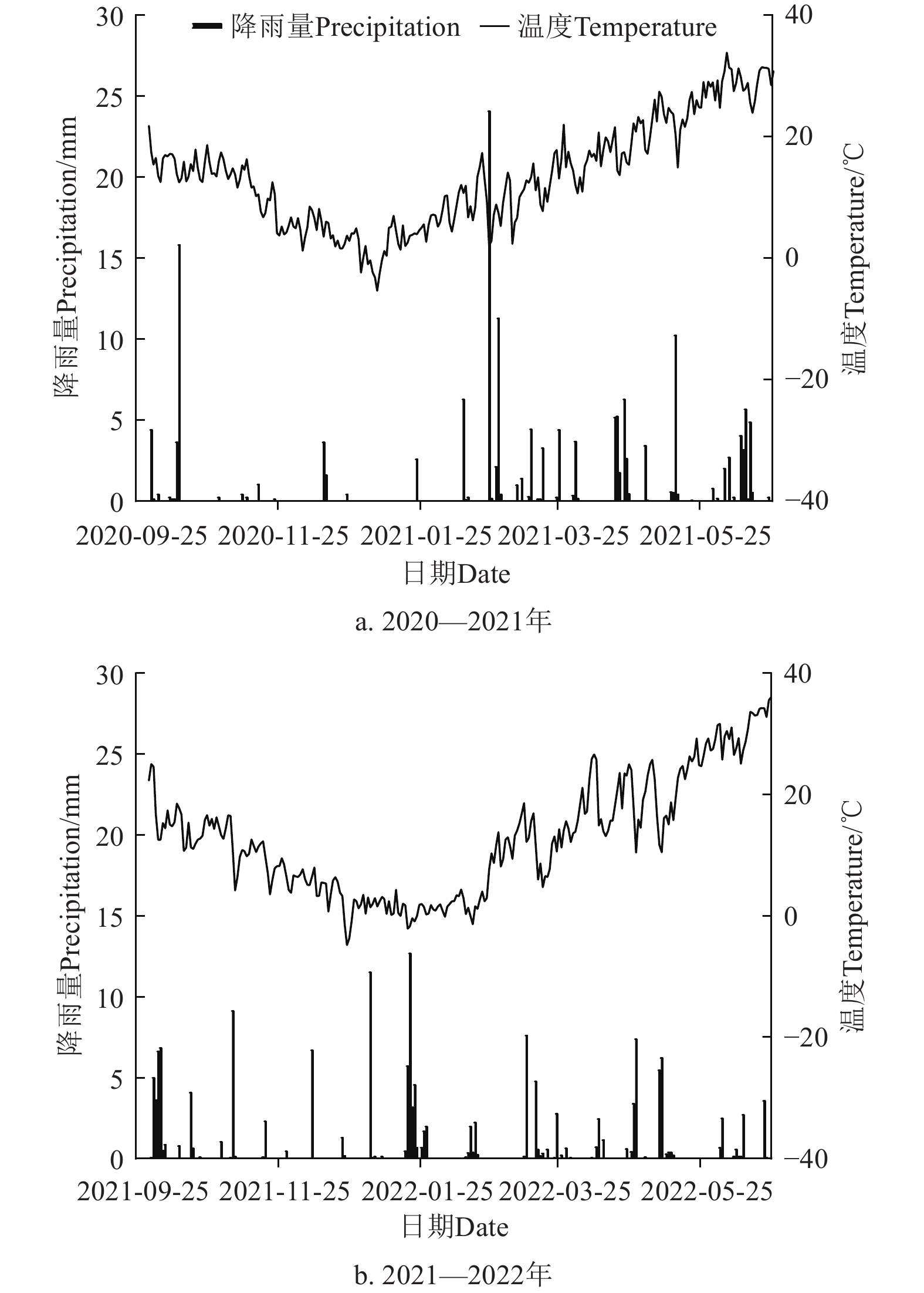| [1] |
卢秉林,包兴国,车宗贤,等. 长期留茬免耕对河西绿洲灌区春小麦产量及稳定性的影响[J]. 农业工程学报,2022,38(7):117-126.
LU Binglin, BAO Xingguo, CHE Zongxian, et al. Effects of long-term no-tillage with crop stubbles on yield and stability of spring wheat in Hexi Oasis Irrigated Areas[J]. Transactions of the Chinese Society of Agricultural Engineering (Transactions of the CSAE), 2022, 38(7): 117-126. (in Chinese with English abstract)
|
| [2] |
缪丽娟,刘冉,邹扬锋,等. 黄淮海平原气候变化及对粮食产量影响研究综述[J]. 河南农业大学学报,2023,57(1):10-20.
MIAO Lijuan, LIU Ran, ZOU Yangfeng, et al. A review of climate change in Huanghuaihai Plain and its impact on grain yield[J]. Journal of Henan Agricultural University, 2023, 57(1): 10-20. (in Chinese with English abstract)
|
| [3] |
唐晓培,宋妮,陈智芳,等. 黄淮海地区冬小麦种植北界时空演变及未来趋势分析[J]. 农业工程学报,2019,35(9):129-137.
Tang Xiaopei, Song Ni, Chen Zhifang, et al. Spatial-temporal distribution and change trend of northern limit of winter wheat planting in Huang-Huai-Hai Plain[J]. Transactions of the Chinese Society of Agricultural Engineering (Transactions of the CSAE), 2019, 35(9): 129-137. (in Chinese with English abstract)
|
| [4] |
FAN J L, MCCONKEY B G, LUCE M S, et al. Rotational benefit of pulse crop with no-till increase over time in a semiarid climate[J]. European Journal of Agronomy, 2020, 121(1): 1-11.
|
| [5] |
刘湘君,乔冠宇,郭丰浩,等. 基于最小数据集的黄淮海旱作区耕层土壤质量评价及障碍分析[J]. 农业工程学报,2023,39(12):104-113.
LIU Xiangjun, QIAO Guanyu, GUO Fenghao, et al. Evaluation and obstacle analysis of cultivated horizon soil quality based on MDS in the dry farming areas of Huang-Huai-Hai Region[J]. Transactions of the Chinese Society of Agricultural Engineering (Transactions of the CSAE), 2023, 39(12): 104-113. (in Chinese with English abstract)
|
| [6] |
王玉珑,于爱忠,吕汉强,等. 绿洲灌区小麦秸秆还田与耕作措施对玉米产量的影响[J]. 作物学报,2022,48(10):2671-2679.
WANG Yulong, YU Aizhong, LYU Hanqiang, et al. Effects of wheat straw returning and tillage practices on corn yield in oasis irrigation area[J]. Acta Agronomica Sinica, 2022, 48(10): 2671-2679. (in Chinese with English abstract)
|
| [7] |
卢秉林,车宗贤,包兴国,等. 留茬免耕播种对河西绿洲灌区春小麦出苗和产量的影响[J]. 应用生态学报,2021,32(9):3249-3256.
LU Binglin, CHE Zongxian, BAO Xingguo, et al. Effects of no-tillage sowing with crop stubbles on seeding emergence and yield of spring wheat in Hexi Oasis Irrigated Area, Northwest China[J]. Chinese Journal of Applied Ecology, 2021, 32(9): 3249-3256. (in Chinese with English abstract)
|
| [8] |
王群,王建,张学林,等. 不同耕作模式下小麦玉米周年生产及土壤养分变化特征[J]. 河南农业大学学报,2015,49(4):429-437.
WANG Qun, WANG Jian, ZHANG Xuelin, et al. Change characteristics of wheat and maize anniversary production and soil nutrient content under different rotation tillage patterns[J]. Journal of Henan Agricultural University, 2015, 49(4): 429-437. (in Chinese with English abstract)
|
| [9] |
闫雷,喇乐鹏,董天浩,等. 耕作方式对东北黑土坡耕地土壤物理性状及根系垂直分布的影响[J]. 农业工程学报,2021,37(1):125-132.
YAN Lei, LA Yuepeng, DONG Tianhao, et al. Soil physical properties and vertical distribution of root systems affected by tillage methods in black soil slope farmlands in Northeast China[J]. Transactions of the Chinese Society of Agricultural Engineering (Transactions of the CSAE), 2021, 37(1): 125-132. (in Chinese with English abstract)
|
| [10] |
谢迎新,靳海洋,孟庆阳,等. 深耕改善砂姜黑土理化性状提高小麦产量[J]. 农业工程学报,2015,31(10):167-173.
XIE Yingxin, JIN Haiyang, MENG Qingyang, et al. Deep tillage improving physical and chemical properties of soil and increasing grain yield of winter wheat in lime concretion black soil farmland[J]. Transactions of the Chinese Society of Agricultural Engineering (Transactions of the CSAE), 2015, 31(10): 167-173. (in Chinese with English abstract)
|
| [11] |
李福建,徐东忆,吴鹏,等. 机械耕作和播种方式对稻茬小麦光合生产和产量的影响[J]. 农业工程学报,2021,37(5):41-49.
LI Fujian, XU Dongyi, WU Peng, et al. Effects of mechanical tillage and sowing methods on photosynthetic production and yield of wheat in rice stubble[J]. Transactions of the Chinese Society of Agricultural Engineering (Transactions of the CSAE), 2021, 37(5): 41-49. (in Chinese with English abstract)
|
| [12] |
GIZACHEW T G, THOMAS K, LARS J M, et al. Short-term effects of loosening and incorporation of straw slurry into the upper subsoil on soil physical properties and crop yield[J]. Soil and Tillage Research, 2018, 184: 62-67.
|
| [13] |
郭星宇,王浩,于琦,等. 耕作对渭北旱塬小麦-玉米轮作田土壤水分和产量的影响[J]. 中国农业科学,2021,54(14):2977-2990.
GUO Xingyu, WANG Hao, YU Qi, et al. Effects of tillage on soil moisture and yield of wheat-maize rotation field in weibei upland plateau[J]. Scientia Agricultura Sinica, 2021, 54(14): 2977-2990. (in Chinese with English abstract)
|
| [14] |
孙海国,LARNEY F J. 保护性耕作和植物残体对土壤养分状况的影响[J]. 生态农业研究,1997(1):49-53.
SUN Haiguo, LARNEY F J. Effects of conservation tillage and crop residues on soil nutrient contents[J]. Chinese Journal of Eco-Agriculture, 1997(1): 49-53. (in Chinese with English abstract)
|
| [15] |
HILL P R. Use of continuous no-till and rotational tillage systems in the central and northern corn belt[J]. Journal of Soil and Water Conservation, 2001, 56(4): 286-290.
|
| [16] |
王玉玲,李军. 黄土旱塬区平衡施肥下不同土壤耕作模式的蓄水纳墒及作物增产增收效应研究[J]. 植物营养与肥料学报,2016,22(1):151-163.
WANG Yuling, LI Jun. Study on soil water storage, crop yields and incomes under different soil tillage patterns with balance fertilization in the Loess Dryland region[J]. Journal of Plant Nutrition and Fertilizers, 2016, 22(1): 151-163. (in Chinese with English abstract)
|
| [17] |
侯贤清,李荣,韩清芳,等. 轮耕对宁南旱区土壤理化性状和旱地小麦产量的影响[J]. 土壤学报,2012,49(3):592-600.
HOU Xianqing, LI Rong, HAN Qingfang, et al. Effects of alterate tillage on soil physicochemical properties and yileld of dryland wheat in arid areas of south Ningxia[J]. Acta Pedologica Sinica, 2012, 49(3): 592-600. (in Chinese with English abstract)
|
| [18] |
于淑婷,赵亚丽,王育红,等. 轮耕模式对黄淮海冬小麦—夏玉米两熟区农田土壤改良效应[J]. 中国农业科学,2017,50(11):2150-2165.
YU Shuting, ZHAO Yali, WANG Yuhong, et al. Improvement effects of rotational tillage patterns on soil in the winter wheat-summer maize double cropping area of Huang-Huai-Hai region[J]. Scientia Agricultura Sinica, 2017, 50(11): 2150-2165. (in Chinese with English abstract)
|
| [19] |
蒋向,贺德先,任洪志,等. 轮耕对麦田土壤容重和小麦根系发育的影响[J]. 麦类作物学报,2012,32(4):711-715.
JIANG Xiang, HE Dexian, REN Hongzhi, et al. Effect of different patterns of rotational tillage on soil bulk density in wheat field and wheat root deveiopment[J]. Journal of Triticeae Crops, 2012, 32(4): 711-715. (in Chinese with English abstract)
|
| [20] |
孔凡磊,陈阜,张海林,等. 轮耕对土壤物理性状和冬小麦产量的影响[J]. 农业工程学报,2010,26(8):150-155.
KONG Fanlei, CHEN Fu, ZHANG Hailin, et al. Effects of rotational tillage on soil physical properties and winter wheat yield[J]. Transactions of the Chinese Society of Agricultural Engineering (Transactions of the CSAE), 2010, 26(8): 150-155. (in Chinese with English abstract)
|
| [21] |
关小康,王静丽,刘影,等. 轮耕秸秆还田促进冬小麦干物质积累提高水氮利用效率[J]. 水土保持学报,2018,32(3):280-288.
GUAN Xiaokang, WANG Jingli, LIU Ying, et al. Rotational tillage with straw returning increased dry matter accumulation and utilization efficiency of water and nitrogen in winter wheat[J]. Journal of Soil and Water Conservation, 2018, 32(3): 280-288. (in Chinese with English abstract)
|
| [22] |
鲍士旦. 土壤农化分析. 3版[M]. 北京 中国农业出版社,2000.
|
| [23] |
王秋菊,刘峰,焦峰,等. 深耕对黑土水分特征及动态变化影响[J]. 土壤通报,2018,49(4):942-948.
WANG Qiuju, LIU Feng, JIAO Feng, et al. Effect of deep tillage on water characteristics in black soil[J]. Chinese Journal of Soil Science, 2018, 49(4): 942-948. (in Chinese with English abstract)
|
| [24] |
李明,李朝苏,刘淼,等. 耕作播种方式对稻茬小麦根系发育、土壤水分和硝态氮含量的影响[J]. 应用生态学报,2020,31(5):1425-1434.
LI Ming, LI Chaosu, LIU Miao, et al. Effects of different tillage and sowing practices on root growth, soil moisture, and soil nitrate nitrogen content of wheat after rice[J]. Chinese Journal of Applied Ecology, 2020, 31(5): 1425-1434. (in Chinese with English abstract)
|
| [25] |
韩娟,廖允成,贾志宽,等. 半湿润偏旱区沟垄覆盖种植对冬小麦产量及水分利用效率的影响[J]. 作物学报,2014,40(1):101-109.
HAN Juan, LIAO Yuncheng, JIA Zhikuan, et al. Effects of ridging with mulching on yield and water use efficiency in winter wheat in semi-humid drought-prone region in china[J]. Acta Agronomica Sinica, 2014, 40(1): 101-109. (in Chinese with English abstract)
|
| [26] |
梁磊,孙浩田,徐高明,等. 田间原位试验分析长期机械作业下稻麦轮作地块土壤入渗性能[J]. 农业工程学报,2023,39(7):110-118.
LIANG Lei, SUN Haotian, XU Gaoming, et al. Soil infiltration of rice-wheat rotation field under long-term mechanical treatment based on field in situ experiments[J]. Transactions of the Chinese Society of Agricultural Engineering (Transactions of the CSAE), 2023, 39(7): 110-118. (in Chinese with English abstract)
|
| [27] |
王玉凤,陈天宇,付健,等. 不同耕作方式对松嫩平原半干旱区玉米生长和产量的影响[J]. 玉米科学,2022,30(2):104-111.
WANG Yufeng, CHEN Tianyu, FU Jian, et al. Effects of tillage methods on maize growth and yield in semiarid area of songnen plain[J]. Journal of Maize Sciences, 2022, 30(2): 104-111. (in Chinese with English abstract)
|
| [28] |
杨佳宇,谷思玉,李宇航,等. 深翻-旋耕轮耕与有机肥配施对黑土农田土壤物理性质的影响[J]. 土壤通报,2021,52(6):1290-1298.
YANG Jiayu, GU Siyu, LI Yuhang, et al. Effects of deep ploughing-rotary tillage combined with organic fertilizer on black soil physical propertie[J]. Chinese Journal of Soil Science, 2021, 52(6): 1290-1298. (in Chinese with English abstract)
|
| [29] |
李玉梅,王根林,孟祥海,等. 不同耕作方式对土壤水分和养分变化的影响[J]. 东北农业大学学报,2018,49(9):54-60.
LI Yumei, WANG Genlin, MENG Xianghai, et al. Effect of different soil tillages on soil moisture and nutrient change[J]. Journal of Northeast Agricultural University, 2018, 49(9): 54-60. (in Chinese with English abstract)
|
| [30] |
王倩. 保护性轮耕对渭北旱作麦田土壤水肥、作物生长和产量的影响[D]. 杨凌:西北农林科技大学,2018.
WANG Qian. Effect of Rotational Conservation Tillage on Soil Water and Fertility, Crop Growth and Yield of Dryland Wheat Field in Weibei Highland[D]. Yangling: Northwest A&F University, 2018. (in Chinese with English abstract)
|
| [31] |
薛兰兰. 秸秆覆盖保护性种植的土壤养分效应和作物生理生化响应机制研究[D]. 重庆:西南大学,2011.
XU Lanlan. The Effect of Straw Mulch Conservative Cultivation on Soil Nutrients Dynamics and Crop Physio-biochemical Mechanisms[D]. Chongqing: Southwestern University, 2011. (in Chinese with English abstract)
|
| [32] |
张向前,杨文飞,徐云姬. 中国主要耕作方式对旱地土壤结构及养分和微生态环境影响的研究综述[J]. 生态环境学报,2019,28(12):2464-2472.
ZHANG Xiangqian, YANG Wenfei, XU Yunji. Effects of main tillage methods on soil structure, nutrients and micro-ecological environment of upland in china: A review[J]. Ecology and Environmental Sciences, 2019, 28(12): 2464-2472. (in Chinese with English abstract)
|
| [33] |
郭书亚,尚赏,汤其宁,等. 不同轮耕方式与生物炭对土壤酶活性、土壤养分及小麦和玉米产量的影响[J]. 作物杂志,2022(3):211-217.
GUO Shuya, SHANG Shang, TANG Qining, et al. Effects of different rotation tillage methods and biochar on soil enzyme activity, soil nutrients and yield of wheat and maize[J]. Crops, 2022(3): 211-217. (in Chinese with English abstract)
|
| [34] |
张琦,王浩,王淑兰,等. 深松轮耕模式对黄土旱塬春玉米土壤理化性质和作物产量的影响[J]. 应用生态学报,2020,31(2):459-466.
ZHANG Qi, WANG Hao, WANG Shulan, et al. Effects of tillage alternation pattern with subsoiling on soil physical and chemical properties and spring maize yield in the Loess Plateau, China.[J]. Chinese Journal of Applied Ecology, 2020, 31(2): 459-466. (in Chinese with English abstract)
|
| [35] |
赵刚,吴会军,张永清,等. 豫西长期不同耕作下土壤肥力质量评价[J]. 中国土壤与肥料,2023(6):1-11.
ZHAO Gang, WU Huijun, ZHANG Yongqing, et al. Evaluation of soil fertility quality under long-term different tillage in western Henan[J]. Soil and Fertilizer Sciences in China, 2023(6): 1-11. (in Chinese with English abstract)
|
| [36] |
王改玲,郝明德,许继光,等. 保护性耕作对黄土高原南部地区小麦产量及土壤理化性质的影响[J]. 植物营养与肥料学报,2011,17(3):539-544.
WANG Gailing, HAO Mingde, XU Jiguang, et al. Effects of conservation tillage on wheat yield and soil physicochemical properties in the southern Loess Plateau[J]. Journal of Plant Nutrition and Fertilizers, 2011, 17(3): 539-544. (in Chinese with English abstract)
|
| [37] |
王昌全,魏成明,李廷强,等. 不同免耕方式对作物产量和土壤理化性状的影响[J]. 四川农业大学学报,2001(2):152-154.
WANG Changquan, WEI Chengming, LI Tingqiang, et al. Effect of different zero tillage on the crop yield and soil property[J]. Journal of Sichuan Agricultural University, 2001(2): 152-154. (in Chinese with English abstract)
|
| [38] |
朱长伟,孟威威,石柯,等. 不同轮耕模式下小麦各生育时期土壤养分及酶活性变化特征[J]. 中国农业科学,2022,55(21):4237-4251.
ZHU Changwei, MENG Weiwei, SHI Ke, et al. The characteristics of soil nutrients and soil enzyme activities during wheat growth stage under different tillage patterns[J]. Scientia Agricultura Sinica, 2022, 55(21): 4237-4251. (in Chinese with English abstract)
|
| [39] |
张玉娇,王浩,王淑兰,等. 小麦/玉米轮作旱地长期轮耕的保墒增产效应[J]. 农业工程学报,2018,34(12):126-136.
ZHANG Yujiao, WANG Hao, WANG Shulan, et al. Soil moisture preservation and improving of crop yield in dry land under long-term wheat/maize rotation[J]. Transactions of the Chinese Society of Agricultural Engineering (Transactions of the CSAE), 2018, 34(12): 126-136. (in Chinese with English abstract)
|
| [40] |
张鑫琪,王迎宾,郝兴宇,等. 不同耕作方式对旱地小麦生长发育、生理代谢及产量的影响[J]. 激光生物学报,2022,31(3):278-288.
ZHANG Xinqi, WANG Yingbin, HAO Xingyu, et al. Effects of different tillage methods on growth, physiological metabolism, and yield of wheat in dryland[J]. Acta Laser Biology Sinica, 2022, 31(3): 278-288. (in Chinese with English abstract)
|
| [41] |
周正萍,田宝庚,陈婉华,等. 不同耕作方式与秸秆还田对土壤养分及小麦产量和品质的影响[J]. 作物杂志,2021(3):78-83.
ZHOU Zhengping, TIAN Baogeng, CHEN Wanhua, et al. Effects of different tillage methods and straw returning on soil nutrients and wheat yield and qualit[J]. Crops, 2021(3): 78-83. (in Chinese with English abstract)
|
| [42] |
黄明,吴金芝,李友军,等. 耕作方式和氮肥用量对旱地小麦产量、蛋白质含量和土壤硝态氮残留的影响[J]. 中国农业科学,2021,54(24):5206-5219.
HUANG Ming, WU Jinzhi, LI Youjun, et al. Effects of tillage practices and nitrogen fertilizer application rates on grain yield, protein content in winter wheat and soil nitrate residue in dryland[J]. Scientia Agricultura Sinica, 2021, 54(24): 5206-5219. (in Chinese with English abstract)
|
| [43] |
黄明,吴金芝,李友军,等. 耕作方式和秸秆覆盖对旱地麦豆轮作下小麦籽粒产量、蛋白质含量和土壤硝态氮残留的影响[J]. 草业学报,2018,27(9):34-44.
HUANG Ming, WU Jinzhi, LI Youjun, et al. Effects of tillage method and straw mulching on grain yield and protein content in wheat and soil nitrate residue under a winter wheat and summer soybean crop rotation in drylands[J]. Acta Prataculturae Sinica, 2018, 27(9): 34-44. (in Chinese with English abstract)
|
| [44] |
牛润芝,朱长伟,姜桂英,等. 豫北潮土区轮耕模式对小麦光合特性、产量及土壤养分的影响[J]. 华北农学报,2022,37(4):182-189.
NIU Runzhi, ZHU Changwei, JIANG Guiying, et al. Effects of rotation tillage pattern on wheat photosynthetic characteristics, yield, and soil nutrients in fluvo-aquic soil in north henan[J]. Acta Agriculturae Boreali-Sinica, 2022, 37(4): 182-189. (in Chinese with English abstract)
|















 DownLoad:
DownLoad: